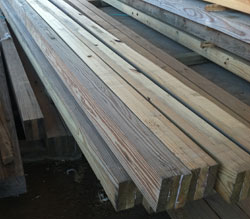Post Frame and Glulaminated Columns
When it comes to using glulaminated columns in post frame buildings, most envision ones where lower portions (usually six to 10 feet) are pressure preservative treated and upper remain untreated. Most of these are products of highly graded Southern Pine and/or MSR (Machine Stress Rated) or MEL (Machine Evaluated Lumber).
 For columns to be mounted into ICC-ESR Code conforming wet-set brackets there are other alternatives. Standard glulams for construction typically have a Fb (fiberstress in bending) of 2400 pounds per inch. This compares favorably to familiar pressure treated lower glulams, where most have a Fb rating of roughly 1900.
For columns to be mounted into ICC-ESR Code conforming wet-set brackets there are other alternatives. Standard glulams for construction typically have a Fb (fiberstress in bending) of 2400 pounds per inch. This compares favorably to familiar pressure treated lower glulams, where most have a Fb rating of roughly 1900.
There are four basic appearance classifications for glulam beams as defined in APA-EWS Form No. EWSY110 and ANSI A 190.1 (although in ANSI A190.1 they are referred to as glulam appearance “grades”). Classifications are as follows: Framing, Industrial, Architectural and Premium. These classifications are summarized below and relate to a glulam beams’ appearance only, not to its strength.
Framing Appearance
This classification is provided to match standard dimensional lumber widths (typically 3-1/2” and 5-1/2” widths). Glulam members will be planed in a “Hit and Miss” fashion. Low laminations, glue smear and glueline squeezeout are permitted. Knot holes, splits and wane are also permitted and will not be filled.
Industrial Appearance
This classification should be used (specified) when appearance is not of primary concern. Loose knots and knot holes appearing on the wide face of laminations (beam bottom) exposed to view will be filled with putty, but voids appearing on lamination edges will not. Occasional misses, low laminations or wane are permitted.
Architectural Appearance
This is a high quality appearance suitable for applications where appearance is important but not an overriding consideration. All exposed knot holes and voids measuring over ¾” will be filled with a wood-tone filler. Exposed surfaces will be smooth and bottom corners (edges) will be eased.
Premium Appearance
This is the highest standard glulam appearance classification. All exposed knot holes and voids will be filled with a wood-tone filler. Exposed surfaces will be smooth and bottom corners will be eased.
For post frame columns above grade, framing or industrial appearance glulams will be most cost effective. Wanting to create some spectacular beamed ceilings or open trusses? If so, architectural or premium appearance might just be your ticket.
Tag Archives: glulam beams
Welcome to Ask the Pole Barn Guru – where you can ask questions about building topics, with answers posted on Mondays. With many questions to answer, please be patient to watch for yours to come up on a future Monday segment. If you want a quick answer, please be sure to answer with a “reply-able” email address.
Email all questions to: PoleBarnGuru@HansenPoleBuildings.com
DEAR POLE BARN GURU: I’m building a 32’x40′ pole barn using 6×6 treated posts on 8′ centers and would like to use a glue-lam beam across the 40′ length, but am not sure how to calculate the size needed to support the roof or if I need to increase the support post size.
This will be the ridge beam. I live in a sparsely populated area of Alaska, but plan on a trip to town soon to look at other similar sized buildings. There are no building regs out here, but I have looked at some large metal buildings blown down by 90 mph winds we had two years ago and another built out of rough cut spruce logs (ridge beam type) that looked pretty simple to build. I planned to use posts sunk 6′ and set in concrete. I always like to err on the safe side, so overkill is OK. MUSHING
DEAR MUSHING: Even in the remote areas of Alaska, there are probably much safer and practical methods to design a pole building rather than trying to utilize a ridge beam 40 feet long. I’d seriously recommend rethinking your design and using prefabricated ganged (two ply or greater) wood roof trusses placed at each sidewall support. This will be much more efficient than the use of a huge beam.
In any case, you need to determine the design load for your site. Here is one possible source: https://www.groundsnowbyzip.com/
The International Building Code also provides a table of ground snow loads for Alaskan locations: https://publicecodes.cyberregs.com/icod/ibc/2012/icod_ibc_2012_16_sec008.htm
You might want to consider getting an engineered pole building kit package, which could be easily shipped out of the Port of Seattle or Tacoma. This would take away your guessing at how to construct it right.
Back to your question….assuming a relatively low roof live load of 40 psf (pounds per square foot), your beam has to be able to support somewhere in the area of 30,000 pounds of weight (this will depend upon the dead loads – what is being used for roofing, etc.).
Assuming the snow will remain on the roof for an extended period of time, a Duration of Load of 1, is probably realistic. This means you will need a 2400f rated glulam with a Section Modulus of around 800 (for information on Bending Moments and Section Modulus read more at: https://www.hansenpolebuildings.com/blog/2012/09/bending-moment/).
In the above scenario, you would be looking at a 6-3/4” x 27” deep glulam beam!! Not only will this be amazingly expensive, but it will also result in the need to hire a crane to set it in place.
DEAR POLE BARN GURU: HEY MIKE…………COULD YOU GIVE ME THE NAMES AND ADDRESSES OF A COUPLE OF YOUR CUSTOMERS IN NYS HUDSON VALLEY AREA? THANKS! NEW YORK NICK
DEAR NICK: Thank you for your continued interest in a new Hansen Pole Building. Among the thousands of building kit packages we have provided are hundreds in New York (as well as every other state in the U.S.A.). We are VERY protective of the personal information of all of our clients, just like we will be of yours. Most people feel very uncomfortable with having “strangers” visit their homes and buildings. It is a security and safety issue, as it would be all too easy for an unscrupulous person to use this method as a way to case things out for “less than helpful” activity. Please click on the Free Product Guide and we will be happy to mail you a very nice 32 page “showroom” of our buildings.
Here is what a few of our clients have to say: https://www.hansenpolebuildings.com/testimonials.htm
DEAR POLE BARN GURU: You have provided a tremendous amount of information and have given us a lot of questions that need answering – Thank you.
One of the major questions we have, what is code to make a living space (studio) type apartment inside one of these structures? The second floor load being 40 psf, can this be increased for living space?
Do you have contractors that can assemble this on our site? What kind of cost would be associated with assembly?
We are in the process of obtaining a VA construction loan with our local credit union and the above questions may be answered through that process.
I’ll take your questionnaire to our building department next Friday to get all those questions answered.
Thanks for your time and patience as we are just starting down this unfamiliar road.
WANTING IN WALLA WALLA
DEAR WANTING: You are very welcome, we try to assist our clients to be as educated as the want to become, so as to make certain the choices they make in the end, are the right ones.
A 40 psf second floor live load would be Code loading for a residential living space. You will need to meet the Washington State Energy Code for level of insulation in relationship to the number and area of openings (doors and windows) in the conditioned space. Whoever designs your HVAC (heating, ventilation and air conditioning) systems can assist you with the proper recommendations to meet the requirements.
While we are not contractors, we do deal with builders who may be able to assist you with your project: https://www.hansenpolebuildings.com/find-a-builder.php
Fair market value for assembly varies greatly depending upon geographical location and the costs of doing business in any particular state. In my mind, a competitive labor quote should be around 50% of the cost of the materials being installed. As it begins to creep upwards from there, I think about strapping on my old nail belt and doing the work myself.
Please do not hesitate to contact us at any time we can assist you.
Glu-laminated columns are a laminated composite product manufactured from high-strength lumber. By using multiple plies of materials, natural defects are randomized creating greater column strength and a higher degree of reliability.
 Hansen Pole Buildings provides glulam columns manufactured by several different companies, so there are some slight variations. This article will speak more to the commonalities between manufacturers and give a broad overview.
Hansen Pole Buildings provides glulam columns manufactured by several different companies, so there are some slight variations. This article will speak more to the commonalities between manufacturers and give a broad overview.
A fairly climate controlled environment is required for glulam fabrication, as the phenol resorcinol glues being used to join the end finger joints and individual plies together require a fairly stable temperature for proper curing.
Most post frame building glulam columns are manufactured from a #1 grade Southern Yellow Pine (SYP) lower portion, which is pressure preservative treated to UC-4B (structural in ground use) specifications and then kiln dried after treatment (KDAT) to moisture content of 15% or less.
The upper portions are most typically either #1 SYP or 1650 msr (machine stress rated) SPF (Spruce-Pine-Fir), either of which is kiln dried. Having the proper moisture content is critical to good adhesive bonding in the glue line.
Individual lower and upper members are finger jointed and the joint is glued together. Good finger joints are actually the most challenging part of the entire manufacturing process. Finger jointing allows for columns to be fabricated up to (depending upon the manufacturer) 64 feet in length, with no butt (square-end to square-end) joints.
Once the joints have cured, each member must be planed. This opens up the wood cells to accept the phenol resorcinol glue uniformly. Each member is then run through a planer which reduces the thickness of the board to from 1-1/2 inches as it was originally milled, to 1-3/8 inches.
The plies are then face glued and secured into presses where they are squeezed under pressure. Once the glue has cured, the columns are removed from the presses and planed to remove excess glue and any abnormalities.
After this final planing, a glulam made from three 2x members will typical measure about 4-1/8 inches in width. For a 2×6 the final depth will be 5-3/8 inches. A 2×8 will be 7-1/8 inches in depth. Four plies will be about 5-1/2 inches in width. While custom dimensions can be created by planing down larger members, the utilization of these dimensions creates the least possible waste and allows for the most value for the investment.
What I like about glulams is they have a high strength to weight ratio (comparing lumber grade to same lumber grade). I can move a good sized glulam beam by myself, or with a buddy, without having to get out the heavy equipment.






